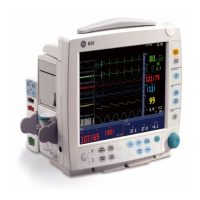B30 Patient Monitor
17-8
Interfering gases
Non-disturbing gases are those with a maximum effect on the CO
2
reading < 0.2 vol%. The
effect is valid for specific concentrations shown in parentheses of the non-disturbing gas:
Ethanol C
2
H
5
OH (<0.3%)
Acetone (<0.1%)
Methane CH
4
(<0.2%)
Nitrogen N
2
water vapor
Dichlorofluoromethane (<1%)
Tetrafluoroethane (<1%)
Disturbing gases and their effect on the CO
2
reading at 5.0 vol-% CO
2
are shown below. Errors
listed reflect the effect of specific concentrations (shown in parentheses) of an individual
disturbing gas and should be combined when estimating the effect of gas mixtures:
Halothane (4%) increases < 0.3 vol%
Isoflurane (5%) increases < 0.4 vol%
Enflurane (5%) increases < 0.4 vol%
Desflurane (24%) increases < 1.2 vol%
Sevoflurane (6%) increases < 0.4 vol%
Helium (50%) decreases < 0.3 vol%
If O
2
compensation is not activated: O
2
(40 to 95%) decreases < 0.3 vol%
If O
2
compensation is activated: O
2
(40 to 95%) error < 0.15 vol%
If N
2
O compensation is not activated: N
2
O (40%) increases < 0.4 vol%, N
2
O (40 to 80%)
increases < 0.8 vol%
If N
2
O compensation is activated: N
2
O (40 to 80%) error < 0.3 vol%
Unit conversions
Relationship between gas concentration and its partial pressure:
Reading in mmHg (dry gas) =
(ambient pressure in mmHg) x (gas concentration in%)
100
Reading in mmHg (water vapor saturated gas) =
(ambient pressure in mmHg - 47 mmHg) x gas concentration in%
100
Reading in kPa (dry gas) =
(ambient pressure in mmHg) x (gas concentration in%)
750
Reading in kPa (water vapor saturated gas) =
((ambient pressure in mmHg - 47mmHg) x (gas concentration in%)
750
NOTE: 47 mmHg is the partial pressure of the saturated water vapor at 37°C.

